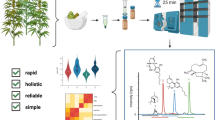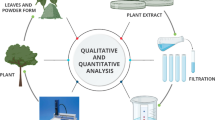Adhatoda vasica Nees, is locally known as adulsa, which is used in various medicinal activities. Hence, an objective of the study was to develop an high-performance thin-layer chromatography method for estimation of vasicine in herbal extract and its marketed herbal formulation. The current study focuses on the stability study for estimation of vasicine by a newly developed, less time-consuming method. In the present study, dried vasaka leaf powder was extracted with 90% methanol to obtain methanolic extract. The method was optimized for the dried methanolic extract using silica gel 60 F254 precoated thin-layer chromatography aluminum plates as the stationary phase and methanol: toluene (8.5:1.5 v/v) as the mobile phase. Detection was carried out in the absorbance mode at 286 nm. The developed method was validated and the extract was subjected to forced degradation studies using acid, alkali, and oxidative, thermolytic, and photolytic degradation as per International Council on Harmonization guidelines. The optimized method gave an Rf value of 0.27 ± 0.02. A good linear relationship was achieved for vasicine in the linear regression data for the calibration curves over the concentration range of 600 – 3600 ng/band (R2 = 0.9992). The limit of detection and limit of quantitation were found to be 200 ng/spot and 400 ng/spot respectively. The percentage content of vasicine was obtained (99.91% for the marketed syrup formulation and 99.87% for the marketed tablet formulation. The developed method gave a good result, which shows its applicability in the determination of vasicine in extract and its various marketed formulations.




Similar content being viewed by others
References
S. K. Singh, J. R. Patel, A. Dangi, et al. , J. Med. Plants Studies, 5, 175 – 180 (2017).
N. Kumar, World J. Pharm. Res., 5, 437 – 455 (2016).
V. Gayathri, V. Bindhu, Ind. J. Pharm. Pharm. Res., 6, 541 – 547 (2016).
V. V. Kadlag, V. S. Kasture, S. A. Gosavi, et al., Asian J. Chem., 23, 1917 – 1921 (2011).
B. K. Sajeeb, U. Kumar, A. S. S. Rouf, et al., Ind. J. Trad. Knowledge, 14, 637 – 642 (2015).
S. Soni, S. Anandjiwala, G. Patel, et al., Ind. J. Pharm. Sci., 70, 36 – 42 (2008); DOI: https://doi.org/10.4103/0250-474X.40329.
P. Ravi Kumar, World J. Pharm. Pharmaceut. Sci., 4, 1075 – 1083 (2015).
S. K. Dinakaran, S. Chelle, H. AvasaralaHYPERLINK “https://www.sciencedirect.com/science/article/pii/S2225411017301335” \l “!” , J. Trad. Complementary Med., 9, 319 – 327 (2019). https://doi.org/10.1016/j.jtcme.2017.12.001.
B. K. Sajeeb, U. Kumar, Md. S. Hossain, et al., Dhaka Univ. J. Parm. Sci., 15, 57 – 62 (2016).
A. Sharma, K. Lal, S. Handa, Pharma Bio, 30, 205 – 208 (2008). https://doi.org/10.3109/13880209209053998
H. N. A. Ram, A. Shirwaikar, Pharmacology online, 2, 53 – 60 (2007).
N. A. Farooqui, A. Dey, G. N. Singh, et al., Asian J. Pharmaceut. Clin. Res., 7, 235 – 240 (2014).
K. R. Brain, B. B. Thapa, J. Chromatogr., 258, 183 – 188 (1983).
S. Muralidhar, S. Shashidhara, P. E. Rajasekharan, et al., Int. J. Drug Developm. Res., 2, 676 – 680 (2010).
K. Dhalwal, V. M. Shinde, K. R. Mahadik, J. Med. Plants Res., 4, 1289 – 1296 (2010).
M. Garg, E. T. Tamboli, P. Rabea, et al., Pharmacognocy Magazine, 10, 198 – 205 (2014).
B. Avula, S. Begum, S. Ahmed, et al., Die Pharmazie - An Int. J. Pharm. Sci., 63, 20 – 22 (2008).
Indian Pharmacopoeia, Government of India, Ministry of Health and Family Welfare, Delhi, India, (1996).
A. O. A. C. Official Methods of Analysis. Association of Official Analytical chemists. EUA, (2000).
S. Y. Gabhe, P. A. Tatke, R. K. Punjabi, Int. J. Pharmacognosy Phytochem. Res., 10, 350 – 354 (2018).
B. R. Keesara, R. K. Jat, Int. J. Res. Developm. Pharm. & Life Sci., 6, 2590 – 2596 (2017).
ICH Topic Q 1 A(R2) Stability Testing of new Drug Substances and Products (2003).
ICH Harmonised Tripartite Guideline, Validation of Analytical Procedures: Text and Methodology Q2 (R1) (2005).
Author information
Authors and Affiliations
Corresponding author
Rights and permissions
Springer Nature or its licensor (e.g. a society or other partner) holds exclusive rights to this article under a publishing agreement with the author(s) or other rightsholder(s); author self-archiving of the accepted manuscript version of this article is solely governed by the terms of such publishing agreement and applicable law.
About this article
Cite this article
Satpute, S.J., Yadav, S.S. & Chopade, S.S. HPTLC Method Development for Estimation of Vasicine in Herbal Extract and its Marketed Formulations. Pharm Chem J 57, 1284–1289 (2023). https://doi.org/10.1007/s11094-024-03036-x
Received:
Published:
Issue Date:
DOI: https://doi.org/10.1007/s11094-024-03036-x




